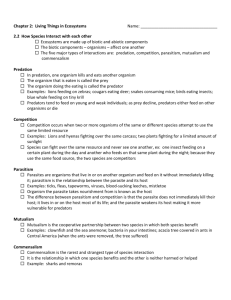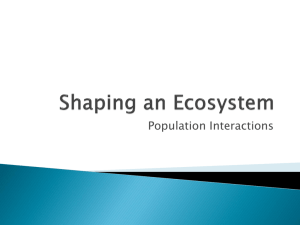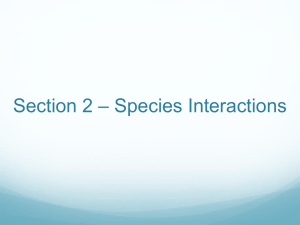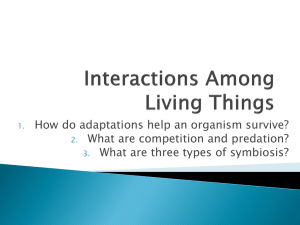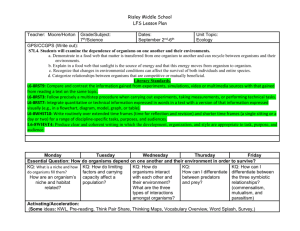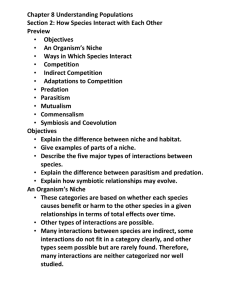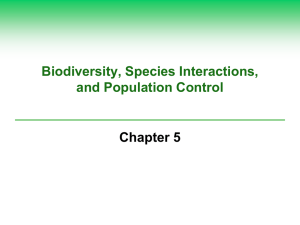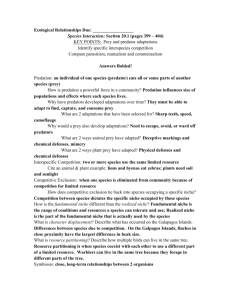Section 2.2 Student notes
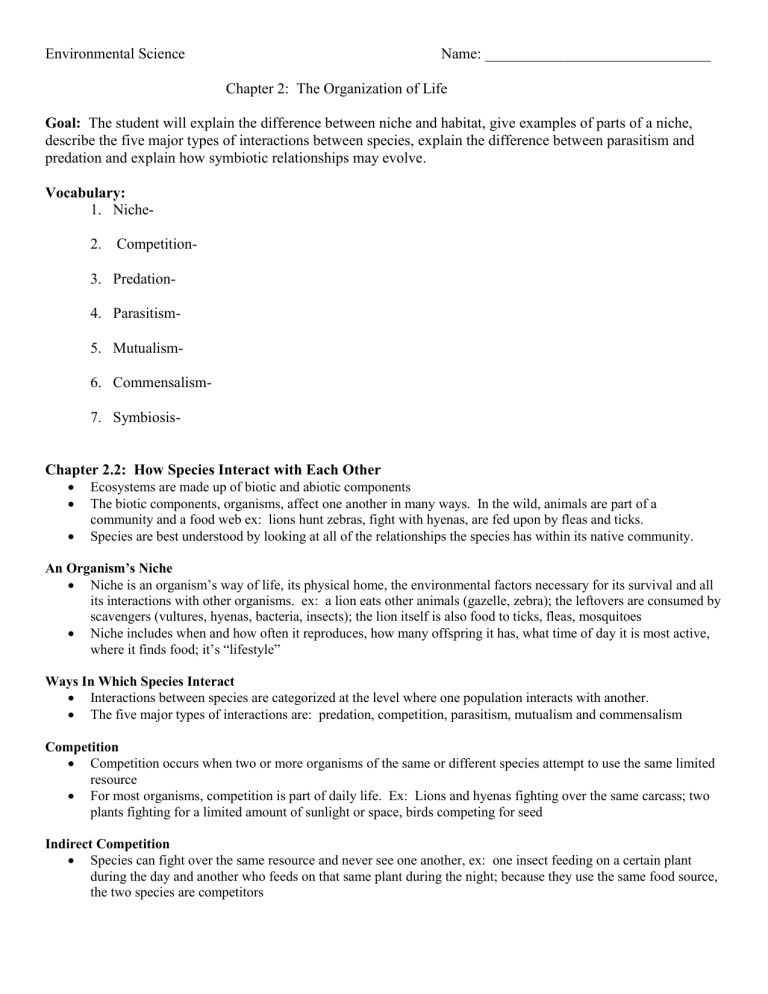
Environmental Science Name: ______________________________
Chapter 2: The Organization of Life
Goal: The student will explain the difference between niche and habitat, give examples of parts of a niche, describe the five major types of interactions between species, explain the difference between parasitism and predation and explain how symbiotic relationships may evolve.
Vocabulary:
1.
Niche-
2.
Competition-
3.
Predation-
4.
Parasitism-
5.
Mutualism-
6.
Commensalism-
7.
Symbiosis-
Chapter 2.2: How Species Interact with Each Other
Ecosystems are made up of biotic and abiotic components
The biotic components, organisms, affect one another in many ways. In the wild, animals are part of a community and a food web ex: lions hunt zebras, fight with hyenas, are fed upon by fleas and ticks.
Species are best understood by looking at all of the relationships the species has within its native community.
An Organism’s Niche
Niche is an organism’s way of life, its physical home, the environmental factors necessary for its survival and all
its interactions with other organisms. ex: a lion eats other animals (gazelle, zebra); the leftovers are consumed by scavengers (vultures, hyenas, bacteria, insects); the lion itself is also food to ticks, fleas, mosquitoes
Niche includes when and how often it reproduces, how many offspring it has, what time of day it is most active, where it finds food; it’s “lifestyle”
Ways In Which Species Interact
Interactions between species are categorized at the level where one population interacts with another.
The five major types of interactions are: predation, competition, parasitism, mutualism and commensalism
Competition
Competition occurs when two or more organisms of the same or different species attempt to use the same limited resource
For most organisms, competition is part of daily life. Ex: Lions and hyenas fighting over the same carcass; two plants fighting for a limited amount of sunlight or space, birds competing for seed
Indirect Competition
Species can fight over the same resource and never see one another, ex: one insect feeding on a certain plant during the day and another who feeds on that same plant during the night; because they use the same food source, the two species are competitors
Adaptations to Competition
When two species with similar niches are placed together in the same ecosystem, we might expect one species to be more successful than the other. However, over the course of evolution, those species develop adaptations which decrease the competition.
1. Dividing up the niche in time or space. Niche restriction is an example. Two barnacle fighting for one space.
One will be found in the upper zone, the other in the lower zone.
Predation
In predation, one organism kills and eats another organism
The organism that is eaten is called the prey
The organism doing the eating is called the predator. Ex: lions feeding on zebras; cougars eating deer; snakes consuming mice; birds eating insects; blue whale feeding on tiny krill
Some predators eat only specific types of prey. Ex: Canadian lynx and the snowshoe hare. The size of the population tend to increase and decrease in linked patterns.
Predators tend to feed on young and weak individuals; as prey decline, predators either feed on other organisms or die
Parasitism
Parasites are organisms that live in or on another organism and feed on it without immediately killing it; parasitism is the relationship between the parasite and its host
Examples: ticks, fleas, tapeworms, viruses, blood-sucking leeches, mistletoe
Organism the parasite takes nourishment from is known as the host
The difference between parasitism and competition is that the parasite does not immediately kill their host; it lives in or on the host most of its life; and the parasite weakens its host making it more vulnerable for predators
Mutualism
Mutualism is the cooperative partnership between two species in which both species benefit. In some cases neither organism can live without the other (bacteria in our intestines)
Examples: clownfish and the sea anemone; bacteria in your intestines; acacia tree covered in ants in Central
America--when the ants were removed, the tree suffered; tree supplies food and shelter to the ants, ants provide protection for the tree
Commensalism
Commensalism is the rarest and strangest type of species interaction
It is the relationship in which one species benefits and the other is neither harmed or helped
Example: sharks and remoras; birds in trees
Symbiosis and Coevolution
A relationship in which two organisms live in close association is called symbiosis. Symbiosis is most often used to describe a relationship in which at least one species benefits.
Can be found between predator (enables them to find, subdue and capture prey) and prey (enables them to avoid, escape and fight off predators); ex: crabs (predator) and marine snails (prey); plants and herbivores
Over time, species in close relationships may coevolve to reduce the harm or improve the benefit of the relationship.
Lesson Reflection:
1.
Complete Types of Species Interactions handout.
2.
Predator/Prey simulation
Assessment:
1.
Give examples of species that have the same habitat but not the same niche that a lion has.
2.
Explain how parasites differ from predators.
Lesson Extension (Technology/Application/Connection to Real World):
PBS Ecological Relationships – Computer Activity
